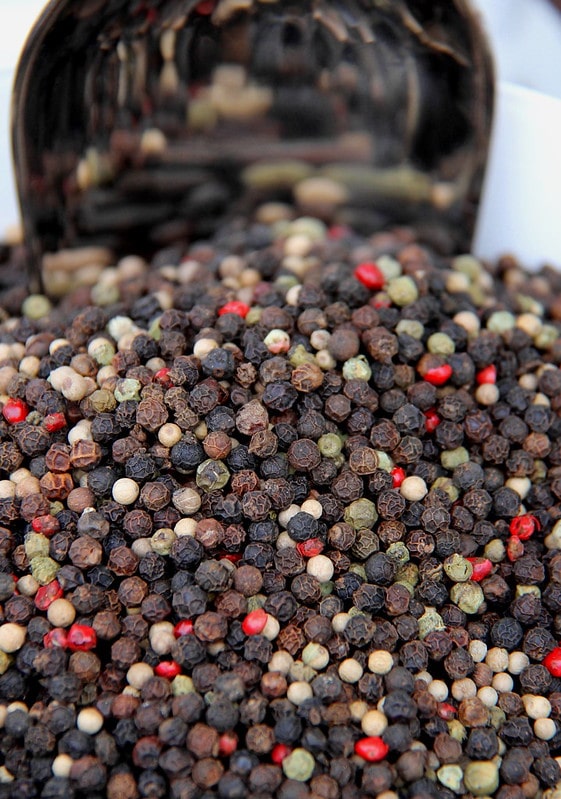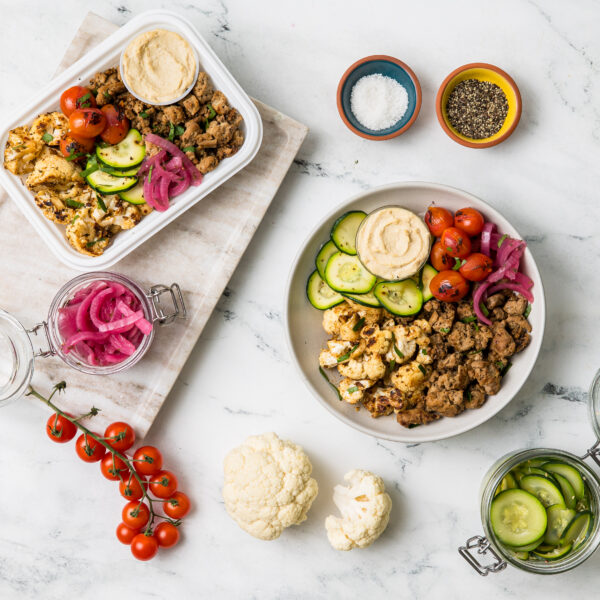Did you know that the most popular spice in the world is pepper? Something we often take for granted is, in fact, the most traded and most sought-after spice!
Nearly every cuisine around the globe uses this slightly spicy, earthy seasoning to elevate the flavors from simple comfort foods like mashed potatoes to complex delicacies like beef wellington.
While you may be familiar with the basic black pepper that’s a staple in your spice cabinet, don’t overlook the unique flavors other types of peppercorns can deliver to your plate. Here’s everything you need to know about the five different types of peppercorns, including their origins, distinct taste, and best foods to pair them with.
What Are Peppercorns?
Before diving into the nuances of peppercorn, we should cover the basics. When we’re talking about peppercorn, we’re referring to the dried fruit of the flowering pepper vine, not the pre-ground pepper you can find in your supermarket. Fresh peppercorns that you grind yourself pack a punch of zesty flavor perfect for nearly every savory meal (or to add a kick to a sweet treat).
Where do peppercorns come from?
The pepper plant is native to India and Indonesia (where the spice trade originated). The berries are picked before they are fully ripe (depending on the desired flavor) and then cooked and dried, sometimes even in the sun. Today, the pepper vine can be found in many tropical climates, and other varieties of peppercorn even come from a different shrub.
Breaking Down The Different Kinds of Peppercorn
Not all the pepper you see at your grocery store is the same. Let’s break down the five types of peppercorns you should know about:
Black Peppercorn
As we said, black pepper is the most common and well-known type of peppercorn that is in nearly every person’s pantry. For black peppercorns, the berries of the vine are picked just before they’re fully ripe and then dried until the skin turns black. This peppercorn has the strongest flavor and tastes the best when it’s freshly cracked.
Black peppercorn is used in many rubs, spices, salad dressings, and peppercorn blends around the world. It’s typically used in savory dishes spanning everything from chicken and beef to soups and salads.
White Peppercorn
Another common peppercorn variety is a white peppercorn. White peppercorns are typically less aromatic and pungent but still have a signature fiery flavor that pepper is known for. To create a light color and unique taste, the berries on the pepper vine are ripened completely before being picked. Then they are washed and have their skin removed before being dried.
Because of its color, white pepper is typically added into light-colored sauces (like alfredo) or soups such as New England clam chowder or a classic potato soup. It easily blends into these dishes without overpowering the light flavors that the cream and potatoes bring to the table.
Green Peppercorn
A lesser-known but equally delicious peppercorn is the green variety. These peppercorns are typically sold preserved in brine (or dried). They are created by harvesting the pepper berry well before it’s ripe, so they’re soft, green, and overall have a fresher and milder flavor than other dried peppercorns.
Since most green peppercorns are brined, they have a fresh and tart taste to them. They are a great accompaniment to steaks, patés, sauces, and even mustard that you want to elevate with a pop of flavor.
Pink Peppercorn
Pink peppercorns are where things begin to deviate from the previous pepper family. That’s because pink peppercorns as you know them aren’t really peppercorns at all! They’re actually the dried berries from the Brazilian pepper tree, which is also known as the Christmas berry tree.
These berries look so similar to peppercorns that they’ve gotten lumped in with them over time. However, their distinct color is very pretty, and pink peppercorns also have citrus and floral notes that make them stand out from true peppercorns. While pink peppercorn complements mild meats like chicken and fish, it’s also often used in sweet treats like chocolates and jellies to add another layer of flavor.
Sichuan Peppercorn
Sichuan peppercorns also fall into this category of faux pepper. Rather than being true peppercorns, these actually are seed husks. Because of this, they don’t have the pungency or the sharp bite of black, white, or green pepper. Similar to a pink peppercorn, Sichuan peppercorns have a more citrus-forward flavor and after a bit of time, leaves your mouth feeling deliciously tingly.
Sichuan peppercorn is popular in Chinese cooking and pairs great with noodle and beef dishes that use other Asian ingredients.
Perfect Peppercorn Pairings at Snap Kitchen
We use pepper in most of our Snap Kitchen meals to make sure we’re fully bringing the flavor, but it’s truly the star of our Peppercorn Steak. We took sirloin steak to the next level with our house-made peppercorn sauce that combines the black pepper flavor we love with a mixture of coconut milk, coconut aminos, ghee, and dijon mustard.
Want to learn more about health, wellness, and our favorite recipes? ? Check out the Snap Kitchen blog!





Leave a Reply
No Comments